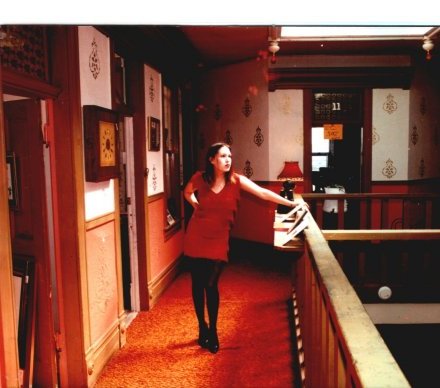The Dumas is an historic American brothel built during the Victorian era in 1890, in what can only be described as brothel style architecture. The Dumas has (42) rooms, each with a distinct layout and purpose, and nearly all are intact to their original design. These rooms range from posh suites and grand parlors, to bare-bone “cribs” -tiny rooms with space only for a twin size bed.
Until the mid 1980’s, the sole purpose of the Dumas was to serve the predominately male population that grew out of Butte’s mining boom. It operated illegally for 92 years from 1890 to 1982, making it America’s longest running house of “ill repute”. The Dumas is the last vestige of Butte’s Red-Light district, maintaining its authenticity as a true 19th century brothel. In the 1970’s, the Dumas was listed on the National Register of Historic Places where it remains today as an active “bordello”. The Dumas is now a museum offering tours of the historic brothel (restorations permitting).

The Dumas was designed and built as a brothel in 1890 and remained active as such until 1982, making it America’s longest running house of prostitution. It was the first two-story brick structure built in Butte’s famous Red Light District along Mercury Street. Ironically, the Dumas is also the last intact ‘survivor’ of an area where vice thrived and women worked hard, lived hard, and sometimes died hard.
In the early 1970’s, the Dumas Brothel was listed on the National Register of Historic Places as an “active bordello.” It is the last known example of the ‘Victorian Brothelese’ style architecture remaining in the United States today. The building is very nearly intact from when it was built at the turn of the 20th century. With the exception of some lowered ceilings and paneling from the 1970’s, very few architectural changes have occurred at the Dumas.
The first owners of the Dumas were the French Canadians Arthur and Joseph Nadeau. Joseph emigrated to the United States in 1868, and in 1878, married Delia, also of French Canadian descent. They arrived at Butte in 1879. Ownership of the Dumas was listed in Delia’s name to avoid conflicts with the Nadeau Company’s more “legitimate” ventures. From 1888 until 1900, Joseph Nadeau was proprietor of the Windsor Hotel and Restaurant at 13 E. Broadway, in the heart of the more respectable business district. Just a few blocks south of this enterprise, lay the Red Light District, which by 1890, had been established along Mercury and Galena Streets, east of Main and West of Arizona streets.
The Nadeaus created the Nadeau Investment Company and by 1922 owned several building in the Red Light District, including the Copper Block, a large brick saloon and hotel, which provided living quarters for area prostitutes, gamblers and others of questionable reputations. The Copper Block, on the corner of Galena and Wyoming streets, just north and east of the Dumas, was demolished in the early 1990’s. Joseph’s imaginative descriptions of himself reflect the changing times: in 1885 he listed his occupation as “landlord,” until 1905 his self-proclaimed title was “capitalist,” and in 1905 he listed his business as “real estate.”
The Dumas is a three level brothel. The lower level (basement) contains smaller rooms or cribs. Originally, a stairway led downstairs from the front side walk. The main level has larger rooms and parlors connected by massive pocket doors, which could be opened to create large parlors for parties, but closed up again to regain the individual rooms. the upstairs (top level) contains several large rooms and suites and a large open balcony with skylights.
In 1913, one story addition was built on the rear of the Dumas containing eight cribs, four of which open to “Venus Alley,” which once was lined with tiny rooms opening directly into the alley. Prostitutes stood in the doorways of each crib, enticing customers. All that’s left of the infamous alley, directly behind the Dumas, is the red brick paving. In its first half-century, 1890-1942, the Dumas used all 43 of its rooms and during busy times, weekends and paydays, ran three shifts of girls. After all, the miners worked ’round the clock’ meaning there were three shifts of miners, offering 24-hours worth of “customers.”
The “ladies” would sit in the windows while the “gentlemen” walked the hallways and window shopped. The prices charged by the girls were negotiable depending on the services requested. For the standard “quickie” charges were .50 to $1 in the early years and by the 1940’s the rate had climed all the way up to $2. In the 1950’s a fellow could “get lucky” for a mere $5 bill and when the Dumas closed in 1982 the base price was still relatively cheap at $20. The “working girls” were only allowed to keep about 40% of the fees but some of them did quite well on tips. They would receive tips in many forms such as cash, jewelry, clothes, groceries, furs and sometimes automobiles. Butte women who clerked in the business districts’ many dress shops and millinery (hat) stores recall that some of the women of the district often dressed in fine clothes and appeared to be perfect ladies.
In January 1943, as part of the war efforts, the federal government ordered all brothels in the US to be closed. It was at this time that the alley and basement cribs were closed, but the Dumas and the other brothels in the Red Light District continued to operate using the waiting room system. The customer would ring the door bell and be escorted to a waiting room where he would be introduced to several of the girls from which to make his choice. To the disappointment of its many customers, Butte’s Red Light District, also known as the Twilight Zone, no longer allowed “window shopping.” But, many people who grew up in Butte still remember women sitting in front rooms of the houses which face on Mercury Street and tapping on the windows with chopsticks as people passed by. One Butte professional now in his 50’s remembers selling the Montana Post, the afternoon paper, which was in the building on the corner of Main and Galena.
“We’d pick up our papers in the alley and then race tot he houses to sell them because the women there gave us good tips.” He recalls the women as “very nice,” sometimes offering a cup of hot chocolate on a bitterly cold winter day. Ruby Garret was the Dumas’ last madam, or, as she prefers, “landlady,” from 1971 to 1982. After the setbacks of the 80’s she was resigned to let the building “go to taxes,” almost hoping to see the Dumas join its neighbors in demolition rather than have remodeling erase the evidence of its former glory.
Other sources: Save the Dumas Brothel on Brothel Sex Guide
Fortunately, in 1990, she met antique dealer Rudy Giecek and ultimately sold him the building with the stipulation that he restore it as closely as possible to its appearance of 100 years ago. Ruby is living testimony to the Dumas colorful past. She knows the story of the bullet holes in the front door, and the history behind the stories of Elinor’s ghost(Since February 7, 1955, when Madam Elinor Knott Committed suicide, her ghostly form, suitcase in hand, has been seen throughout the Dumas’ 43 rooms). She knows the hidey-holes, the secret crawlspaces, the refrigerator specially adapted to serve as a hiding place for Sandra, a particularly “nervous” but much sought after employee who worked at the Dumas until she was 61 years old. Since 1890, the Dumas has had well over 1 million satisfied customers. And, in caring careful hands, the old building is surviving and even thriving as it welcomes thousands more customers of a different kind. A reminder to all who visit of Butte’s notorious past.
The Historic Dumas Brothel
N0. 45 East Mercury Street,
Butte, Montana 59701

